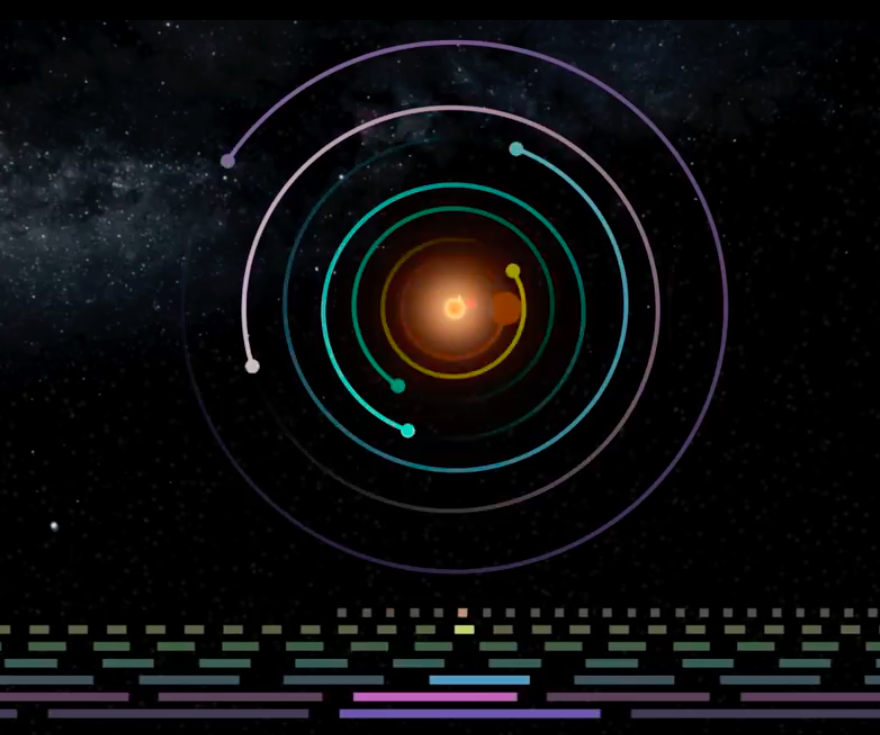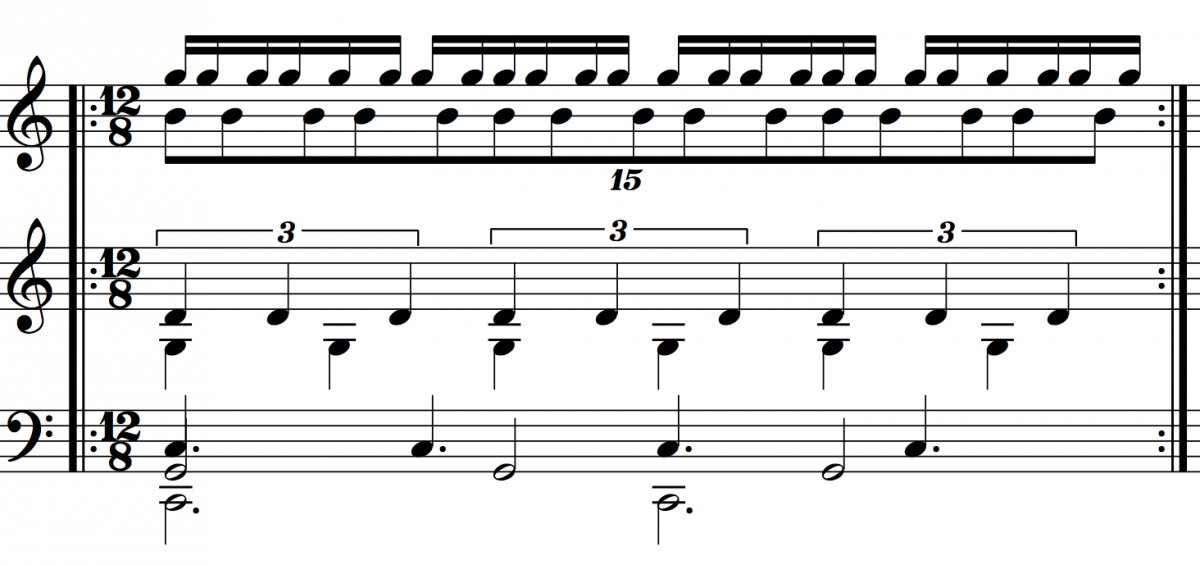The Universe, As Rendered And Explained By Music
Dan Tepfer, Pianist and Science Enthusiast, Walks Us Through the Music of the Cosmos
Dan Tepfer is a pianist and composer whose new album, Eleven Cages, is due out next Friday. He also maintains a keen interest in science — especially astrophysics, the subject of his undergraduate degree. We asked him to elaborate on some recent findings in a faraway solar system, and he came back with this absorbing lesson in the music of planetary orbits.
By Dan Tepfer
Watching the video below made me happy. It brings together two of the things I love most, astrophysics and music. It’s very unusual to find these two subjects talked about seriously in the same sentence, and even rarer when they are able, as in this video, to complement and illuminate each other. Watch as the orbits of planets around a distant star are expressed in sound:
The video was made by astrophysicist Daniel Tamayo, who worked out the planets’ orbits, and Matt Russo, a fellow scientist who also plays jazz guitar. Musician Andrew Santaguida contributed as well. Is there something about jazz that encourages this kind of cross-pollination?
I’m a jazz musician, but I studied astrophysics for my bachelor’s and have always loved science, so it feels natural to me that these two worlds belong together. Thinking about natural processes and mathematics has informed my composing for a long time. And while many artists remain math-adverse, there’s a small but significant number of musicians who think along similar lines. (Composer and saxophonist Steve Coleman, whom I heard at the Village Vanguard last week, is an inspiration to many in this regard, and has used orbital ratios in his work.)
So, what’s going on in this video? How, in the first place, were these orbits figured out? It’s only in the past 25 years that we’ve been able to detect planets in orbit around stars other than our own. This is mainly done indirectly, by (for example) measuring faint dips in a star’s brightness as planets pass in front of it.
In 2015, using this technique, three exoplanets, as planets outside of our Solar System are called, were discovered orbiting around TRAPPIST-1, a dwarf star about 40 light-years away from us in the Aquarius constellation. In February 2017, four more were discovered. The field of exoplanet detection has gotten so advanced that scientists are able to determine not only the size and mass of these planets, but also their orbital periods and — most amazingly — their chemical composition. Three of TRAPPIST-1’s planets are considered to be within its habitable zone, where life could potentially be sustained. Some may even have liquid water on their surface.
This is remarkable enough already. But what makes the TRAPPIST-1 system even more special is the relationships between its planets’ orbits. The farthest planet completes one orbit every 18 Earth days, and the next farthest once every 12. What’s 18 divided by 12? That’s 1.5, or 3/2. In other words, in the time it takes the farthest planet to go twice around the star, the next farthest has gone around three times.
We hear sound when the air around us vibrates and those vibrations reach our ears. Vibrations are a bit like orbits — they repeat at a certain frequency (the note A in the middle of a piano, for example, vibrates 440 times per second). What does it sound like when sounds vibrate in that same 3/2 ratio, one sound vibrating twice in the time it takes the other to vibrate three times? As Pythagoras discovered long ago, it sounds lovely. The musical interval which results, the so-called perfect fifth, is one of the fundamental building blocks of harmony — and not only Western harmony. It turns up in traditional music from all around the world, in every possible key. It sounds like this:
This is a less basic interval than the perfect fifth, but it’s still part of the fundamental material of music. Like the perfect fifth, it’s a consonant interval, meaning its sounds seem to belong together; the relationship sounds harmonious to our ears. Let’s pause here for a moment to consider what we’re talking about: that some planets orbiting a star unfathomably far away from us are doing so in a way that sounds good to us. Isn’t that something?
What’s more, we’re capable of hearing relationships like 3/2 and 8/5 in other ways than through harmony. As I’ve written about before, pitch and rhythm are the same thing, expressed at different time scales. We can hear 8/5 as an interval between two pitches, and we can also hear it as a rhythm in which one sound is played eight times in the time the other is played five:
What does this rhythm sound like?
Pretty catchy, I would say! What’s important to appreciate is that this is exactly the same as hearing a minor sixth as harmony, only about 200 times slower. Pitch and rhythm are simply two different ways for us to perceive frequency relationships. It’s even possible to experience one turning into the other, and back again:
Pretty, right? Now let’s hear these same relationships as rhythm, but instead of playing each note with a percussive sound as we did before with the minor sixth, let’s express each with the pitch that results from the orbital relationships. For fun, here it is in musical notation:
But wait, something’s off — if you’re listening closely, you may have noticed that this is quite a bit more in tune and in time than the sounds and rhythms played in the video at top. This is because, although the TRAPPIST-1 system has relationships that are very close to whole numbers, they’re actually a little off. Nature is funny that way. The outermost planet doesn’t orbit on exactly 18 days, but rather 18.766. The second farthest planet goes around in 12.353 days rather than 12. So their relationship isn’t quite 1.5, but rather 1.51918. We’ve been listening to an idealized version of the system so far. Let’s see what the real thing sounds like, with the most precise orbital periods plugged in, first as pitch, then as pitch and rhythm:
It still sounds quite harmonious, if a little sour (it’s worth comparing to the two previous recordings above). The discrepancies are particularly noticeable in the rhythm, which doesn’t line up quite as neatly as before. The intervals making up the harmonies aren’t as clean, either, but they still “work” — we still hear a clear, quite consonant chord (the history of tuning systems tells us that there is always a little lee-way with tuning). One result of recreating this rendering for myself was to notice that there is a wobble, or vibrato, in the piano-like sound that the TRAPPIST-1 physicists used in their video. To my ears, this causes the harmonies to sound a little further out of tune than they actually are. I’m using simpler, more stable sounds in my own rendering.
So — TRAPPIST-1 is remarkable. Without interfering with its orbits in any way, by just presenting the data scaled up to our range of hearing, we hear what we readily identify as harmonious music. But how special is it? To compare, I wanted to listen to our own Solar System. From Mercury’s 88-day orbit to Neptune’s 165-year one, our home planets take a lot longer to orbit the Sun than TRAPPIST-1’s do. But their relationships — Earth to Mars relate by about 17/9, for example — can be rendered in music just as well.
Meanwhile the outer planets Jupiter, Saturn, Uranus and Neptune together have something of a half-diminished color:
If I assign an extremely low note to Neptune, a low 23Hz rumble right at the bottom of our audible range, that puts Mercury’s sound right at the top of what we can hear, a mere dog whistle at 15,736Hz — which younger listeners will have more success hearing than older ones. Even if we’re able to hear this, we just don’t have the perceptual capacity to hear real harmonic relationships between tones spread that far apart.
For that reason, I’ve transposed the inner four planets down by 2 octaves, and the outer four up by 1 octave. As you’ll remember from music theory class, if you were there, this doesn’t alter the resulting harmony (think chord inversions) — it just allows us to hear it. Here is the sound of our Solar System, from Neptune through Mercury:
There’s no doubt when we hear this that the Solar System isn’t anywhere as harmonious as TRAPPIST-1. Not even in the same ballpark. I actually like the sound that results — it has a mystery that I find enticing — but it’s wildly dissonant. While there are some near-resonances in the Solar System — Uranus makes nearly two orbits in the time it takes Neptune to make one, for example — most of them are too far out of tune to qualify as harmonious.
The fact that the TRAPPIST-1 orbits are so obviously harmonious in comparison tells us something important about the physics of the system. The planets are so close together that they would collide with each other if they hadn’t settled into these resonant orbital relationships. Meanwhile, the planets of the Solar System are far enough apart that they face fewer demands on their orbits.
He was following in the footsteps of the ancient Greeks, who advocated for a Harmony of the Spheres over 2,000 years ago. It turns out people have been trying to listen to planetary orbits for a very long time; it’s remarkable that we live in a time where we can listen not only to our own, but to planets around other stars as well.
Aristotle and Kepler would have had to believe that life in the TRAPPIST-1 system, if indeed there any, is pretty dandy. It’s hard to imagine a system with more harmonious planets.
Or is it? I’ll leave you with a sound rendering I made of the four Galilean Moons of Jupiter, both in pitch and rhythm. Io, Europa, Ganymede and Callisto have orbits that are perhaps even more harmonious than those of TRAPPIST-1, with a beautiful minor key sonority. Three of the moons are in quasi-perfect octaves, a 2 to 1 relationship that is the simplest there is. I guess life must be pretty good there, too.





